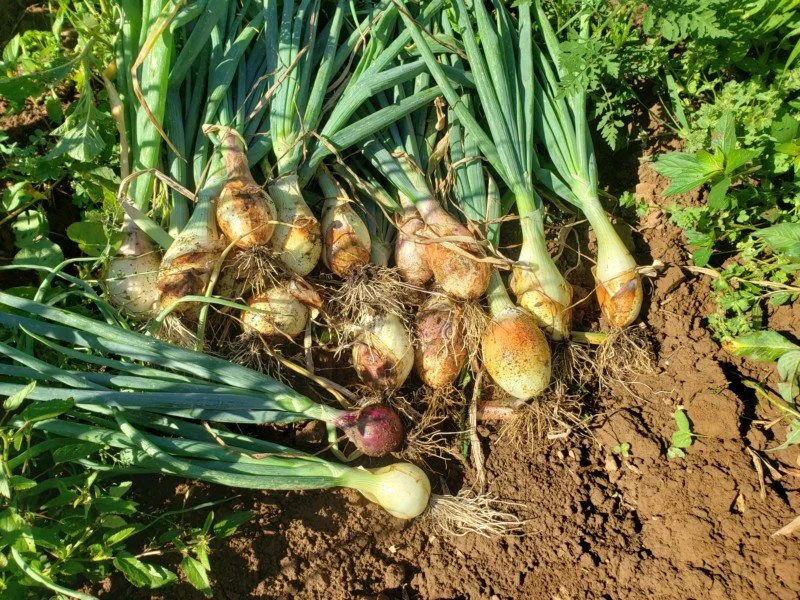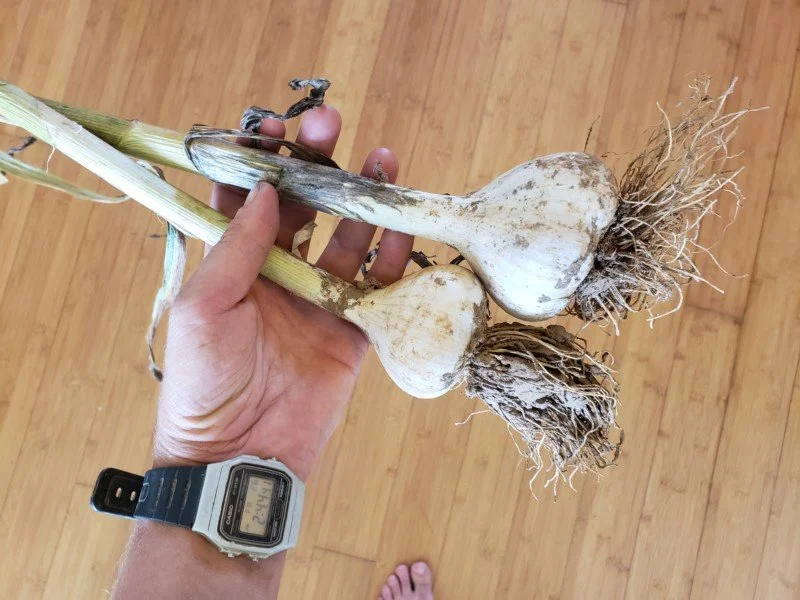All About Alliums
Alliums are one of my favorite things to eat, and now that I'm getting the hang of it, they are staring to be one of my favorite things to grow, as well! Alliums are the onion family. Onions, garlic, leeks, scallions, and chives are all considered alliums. Alliums are very versatile in the kitchen and almost every dish includes them in some form. Raw, they are pungent. Cooked slow, they are sweet.
An allium-heavy cookout spread featuring grilled Ailsa Craigs, caramelized leek-and-onion tart, cucumber-onion-fennel salad and a smear of roasted garlic. Also: okra pickled and grilled and grilled squash
Onions!
The past couple years, we’ve had a great onion harvest and we're hoping the trend continues. Last year was this is the very first year we have grown onions on a drip irrigation system and it really paid off! Lat year during the drought, Nat was able to water those beds frequently during the dry spell and they drink up every drop compared to the crops to either side of them. Nat switched the fittings on that header line so that he can turn off every bed BUT the onions, giving them all the water they can drink as they enter the last stage of growth, bulbing. This year, rains were a bit more regular, but we still used that irrigation to get the plants off to a good start before the weeds came in.
All about onion bulbing
A previous breakthrough we had on the farm regarding onions is realizing that there are different varieties of onions that are best suited to certain latitudes. Onions, like all plants, begin life in a vegetative state, putting energy into leaf growth. Eventually, the day length triggers a switch, where the onions begin putting energy into bulb growth instead. The onions are classified in three categories: long day, short day, and intermediate day. This is why the solstice is important! At our latitude, the solstice has 14+ hours of sunlight.
A good seed company will be able to tell you what type of onion it is and some varieties (like Ailsa Craig) are fairly widely adaptable. When we first began growing veggies on Bellair, we were using Jamie's tried-and-true varieties from New England, not knowing that their bulbing was delayed because they were waiting for that 14-hour day! We now use Ailsa Craig and 2 intermediate-day onions, Cabernet and Scout, for our storage varieties, and they should begin bulbing before the soltice, not on the soltice. That means they be fat before the dry hot summer knocks the life out of the leaves! Check out this guide from our seed company, Johnny's Selected Seeds, for a more exhaustive explanation on the daylength thing.
Above, Ailsa Craig sweet fresh onions. Below, rounder storage onions that mature a little later.
Not only do onions want lots of water, but they want varied nutrients: lots of nitrogen during the vegetative phase and lots of phosphorous during the bulbing stage. I learned from a visit from our Johnny’s rep this year that you can judge the beginning of bulbing when the plant has about 8 leaves. Getting into the nitty-gritty of this type of plant feeding has taken us years but should pay off for us. We are always striving to be better growers!
We will pull the earliest onions, Ailsa Craigs, continuously as they bulb up to size. Every 3-4 days, we go through the beds pulling the biggest ones and by the time we come back through, more have sized up! The fresh onion season is unfortunately very short — sometimes just 3-4 weeks long. The storage onions will be right behind them. We know it’s time to pull those when the tops start to flop over, and we will we will harvest them all at once and lay them out to dry in front of as much ventilation as we can get. In the gap between fresh and storage onions, we can turn to other alliums in our repetoire.
Scallions!
These, we plant several successions of so that we will have them for many weeks out of the season. They are our first allium and sometimes our last as well. We start them out as seeds in the greenhouse, planing them about 4 per cell, then we transplant those into the fields. In peak summer, scallions might taste a little too strong for raw eating (all just depends on your palate). If that's the case, treat them like a leek and saute them just gently before incorporating them into a dish. We grow a variety called Nabechan that holds its flavor as well as possible when it’s large, and in spring, it makes a great “Negi onion,” a Japanese style spring onion.
Garlic harvest 2021
Garlic Harvest 2022
Garlic!
We’re trying to expand our garlic crop year-by-year, but we are doing it slowly because the seed is extremely expensive! We are trying to save our own to cut back on costs, but it’s hard because it’s hard to keep from eating/distributing it all! Lately, our garlic crop has looked giant and gorgeous! Garlic works on a different timeline than most our other seasonal crops. We plant in October or November and then we pull the scapes in late May and the garlic itself just a short 3-4 weeks later. Since scaping, the bulbs will have doubled or more in size. We can tell they are ready for harvest by looking at the size (I pull one or two up every week or so) and by seeing the leaf tips turning brown. If we wait too long, they will begin to rot and the stems will pull out but the cloves will stay there. That's why time is of the essence and we will bring it all in right away. Once pulled, we bunch the garlic and hang it to cure for 2+ weeks before giving it out! In mid-summer, you can see our garlic crop curing in the barn rafters. We will have garlic available for at least a few weeks this summer, and farm garlic is truly on another level if you haven't had it.
Caramelized leek and onion tart! Two alliums, one great tart! Made in 2022.
Leeks!
In 2022, leeks make their comeback on Bellair Farm! We’d grown these for a few years under the management of Jamie Barrett, but ditched them once the CSA grew larger and we struggled to find space and keep them weed-free enough to size up over their long season. Emboldened by our new success with our onion crops, Nat and I planted an experimental-quantity of leeks this year, and it’s gone well! Instead of growing them on a 2-row bare-ground system (with hilling them and overhead water), we put them 3-rows to a bed on plastic and drip, just like our onions. The plastic keeps the weeds down, the drip line makes watering easier. For 2022, we’ll have a small (1-2 week) leek season and we hope to increase that for next year! Leeks can be used anywhere onions are and their sweet and tender flavor is unique!





